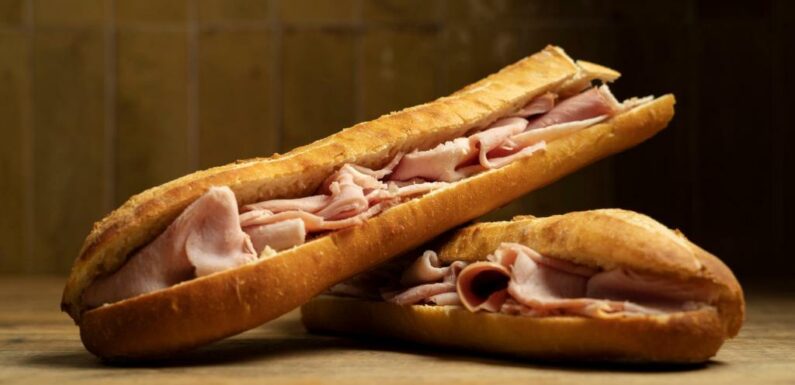
By Florence Fabricant, The New York Times
Jambon beurre, meaning ham-butter, or just ham on buttered baguette, might be the quintessential French sandwich. It’s a staple for a picnic or a quick lunch with a tot of Beaujolais. And it sounds easy enough.
But, as Pierre-Antoine Raberin recalled, it prompted chef Alain Ducasse to note that “the simpler things can be most difficult.”
Raberin, who owns L’Ami Pierre, a new cafe in midtown Manhattan, with chef Eric Ripert, seconded that assessment, pointing out that the ideal jambon beurre — say, what you might find at countless cafes in Paris or what his kitchen will prepare for you — isn’t easy to replicate at home.
“Freshness and temperature are the keys,” he said. At the cafe, which considers that particular sandwich its signature, baguettes come out of the oven every hour or so. The butter it uses, from an upstate farm, is notably rich — about 85% butterfat (the supermarket standard is 80%) — and kept soft and spreadable.
Raberin also said both sides of the baguette are buttered. Some purveyors, like Le Petit Parisien, a French-style sandwich spot that started in the East Village in 2015, and has branched out into Harlem and, as of a month ago, the Upper East Side, butter only one side.
As for the ham, it “should not be cold,” Raberin said, “and it’s important to be generous with it.” L’Ami Pierre uses lightly smoked, thinly sliced cooked ham, also from an upstate purveyor, and piles about four ounces on each sandwich.
Of course, the home sandwich-maker could go to a bakery for a fresh baguette and warm it in the oven. And many markets sell high butterfat butter. But the ham is the challenge: Everyday boneless deli ham will not do since such products often contain water or brine.
What the French call jambon de Paris, cooked ham, preferably on the bone and freshly sliced, is the goal. Some fancy food markets, including Schaller & Weber and Agata & Valentina, sell it. Les Trois Petits Cochons makes and sells it at a number of stores and online sites. Italian prosciutto cotto, cooked ham, also carried by specialty markets, is a good substitute.
You can find jambon beurre at a number of spots across the city, like Frenchette Bakery, Balthazar, the new Pavé and Épicerie Boulud, where it comes with slices of Gruyère. And the advantage to buying, not making, the sandwich is a matter of French fashion: It will come partly cut in half and tightly wrapped in paper, just one end peeking out, and like a perfectly tied scarf, with that touch of French panache.
Recipe: Jambon Beurre
Unlike ham and cheese, a sandwich that’s ubiquitous across the globe, jambon beurre (ham butter) is strictly French. Though it’s a seemingly sparse construction — simply baguette, cooked ham and butter — the ingredients for this interpretation from L’Ami Pierre in New York require careful selection. High-quality baguettes are now sold in many bakeries. High-butterfat butter enhances the sandwich, providing more fat than 80% supermarket standard, and the ham, preferably silky jambon de Paris, a cooked ham sliced, in the finer shops, from a bone-in joint, can make it or break it. French-style or similar cooked ham is available in many areas; to avoid are boneless, often waterlogged deli hams. Like most sandwiches, this one is designed as a treat for one, but, cut into smaller sections and served on a platter, it can enhance a buffet, even at holiday time. — Florence Fabricant
Yield: 1 serving
Total time: 20 minutes
Ingredients
- 1 (10-inch) section fresh baguette
- 1 1/2 tablespoons unsalted butter (preferably 85% butterfat), softened
- 4 ounces thinly sliced cooked ham, preferably jambon de Paris or prosciutto cotto, at room temperature
Preparation
1. Heat oven to 275 degrees. Place baguette in oven and bake 10 minutes, just until the outside crisps. Remove from oven, split in half horizontally and allow to cool to room temperature.
2. When bread has cooled, spread butter on both sides. Pile on the ham. Close the sandwich, cut in half on an angle and serve.
This article originally appeared in The New York Times.
Subscribe to our weekly newsletter, In The Know, to get entertainment news sent straight to your inbox.
Source: Read Full Article